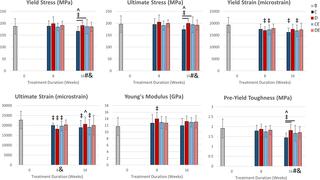PLOS ONE ( IF 3.7 ) Pub Date : 2018-09-21 , DOI: 10.1371/journal.pone.0204470 Michael A. Friedman , Robert P. Szczepankiewicz , David H. Kohn

|
Exercise has long-lasting benefits to bone mass and structural strength even after cessation. Combining exercise with a calcium- and phosphorus-supplemented diet increases cortical bone mineral content (BMC), area, and yield force more than exercise alone in adult mice. These increases could also be maintained after stopping exercise if the modified diet is maintained. It was hypothesized that combining exercise with a mineral-supplemented diet would lead to greater cortical BMC, area, and yield force immediately after a lengthy exercise program and after an equally long period of non-exercise (detraining) in adult mice. Male, 16-week old C57Bl/6 mice were assigned to 9 weight-matched groups–a baseline group, exercise and non-exercise groups fed a control or mineral-supplemented diet for 8 weeks, exercise + detraining and non-exercise groups fed a control or mineral-supplemented diet for 16 weeks. Exercise + detraining consisted of 8 weeks of exercise followed by 8 weeks without exercise. The daily exercise program consisted of running on a treadmill at 12 m/min, 30 min/day. After 8 weeks, mice fed the supplemented diet had greater tibial cortical BMC and area, trabecular bone volume/tissue volume (BV/TV), bone mineral density (vBMD), yield force, and ultimate force than mice fed the control diet. Exercise increased cortical BMC and area only when coupled with the supplemented diet. After 16 weeks, both exercised and non-exercised mice fed the supplemented diet maintained greater tibial cortical BMC and area, trabecular BV/TV, vBMD, yield force, and ultimate force than mice fed the control diet. Combining exercise with a mineral-supplemented diet leads to greater bone mass and structural strength than exercise alone. These benefits remain after an equally long period of detraining. Long-term use of dietary mineral supplements may help increase and maintain bone mass with aging in adult mice.
中文翻译:

补充矿物质的饮食和运动相结合,成年小鼠在八周后增加了骨骼质量和力量,并在八周的训练后保持了增加
即使停止运动,运动对骨骼质量和结构强度也具有持久的益处。将运动与补充钙和磷的饮食相结合,比单独运动对成年小鼠增加更多的皮质骨矿物质含量(BMC),面积和屈服力。如果保持改良饮食,则在停止运动后也可以维持这些增加。假设将运动与补充矿物质的饮食相结合将在成年小鼠中进行长时间的运动计划后,以及经过同样长时间的非运动(训练)后,立即导致更大的皮质BMC,面积和屈服力。将16周大的C57Bl / 6雄性小鼠分为9个体重匹配组-基线组,运动组和非运动组,分别喂食对照或矿物质补充饮食8周,运动+训练和非运动组喂食对照或矿物质补充饮食16周。运动+锻炼包括8周的运动,然后进行8周的无运动。日常锻炼程序包括以12 m / min,30 min / day的速度在跑步机上跑步。8周后,饲喂补充饮食的小鼠比饲喂对照饮食的小鼠具有更大的胫骨皮质BMC和面积,小梁骨体积/组织体积(BV / TV),骨矿物质密度(vBMD),屈服力和极限力。仅在补充饮食的情况下,运动皮质BMC和面积增加。16周后,进食补充饮食的运动和未锻炼小鼠均比进食对照饮食的小鼠保持更大的胫骨皮质BMC和面积,小梁BV / TV,vBMD,屈服力和极限力。与单独运动相比,将运动与补充矿物质的饮食相结合可带来更大的骨骼质量和结构强度。经过长时间同样的培训后,这些好处仍然存在。长期使用膳食矿物质补充剂可能会帮助成年小鼠衰老增加并维持骨量。



























 京公网安备 11010802027423号
京公网安备 11010802027423号